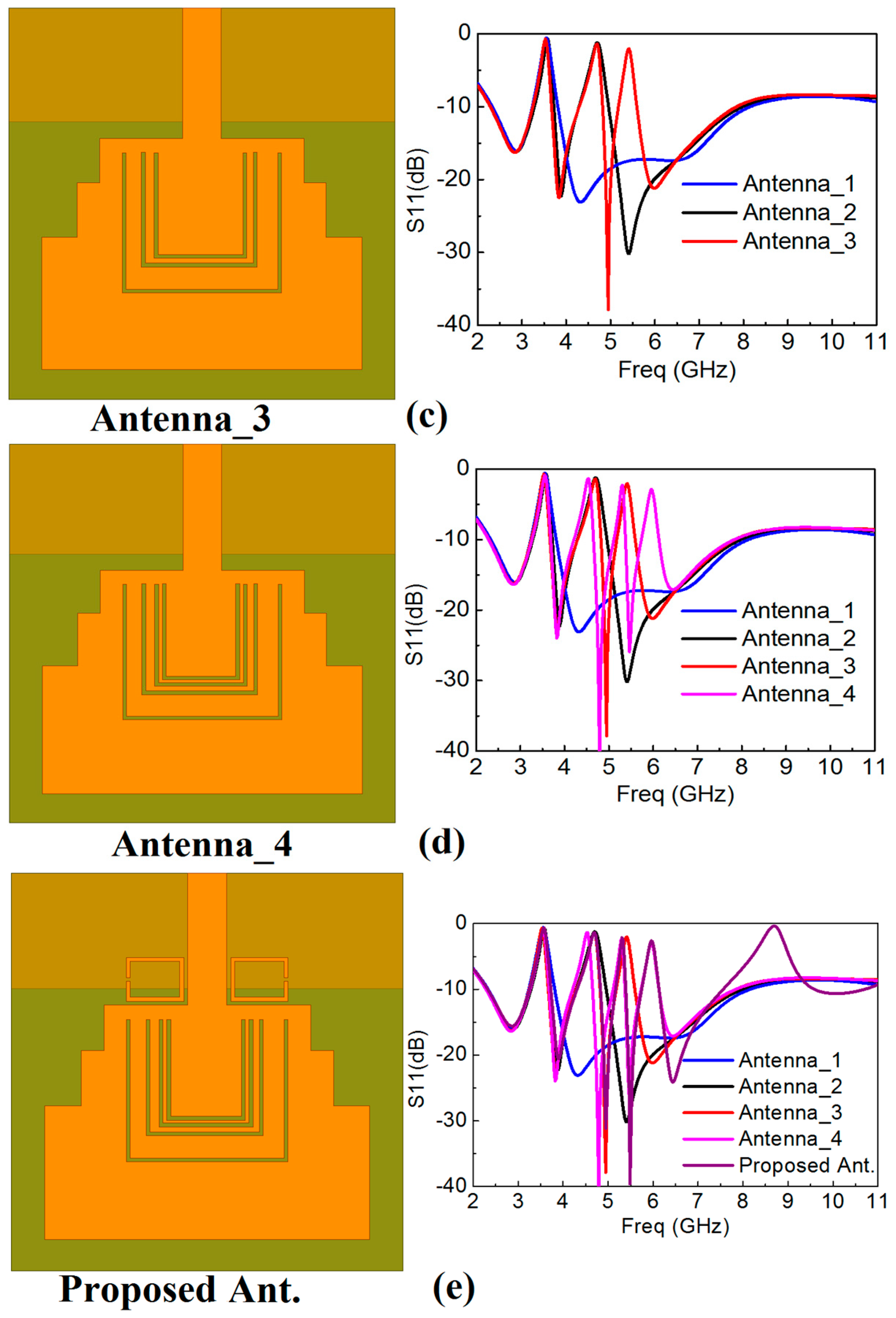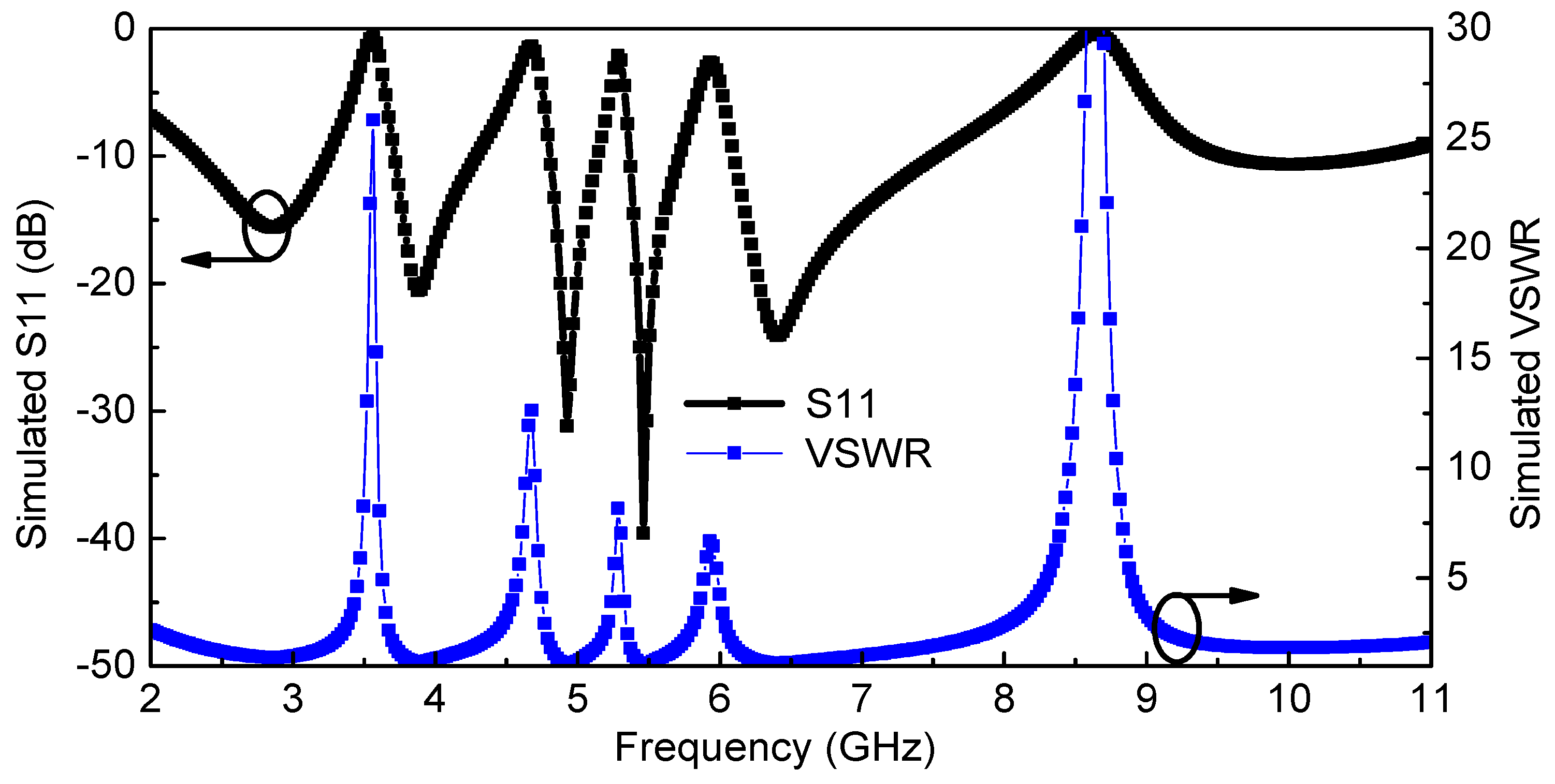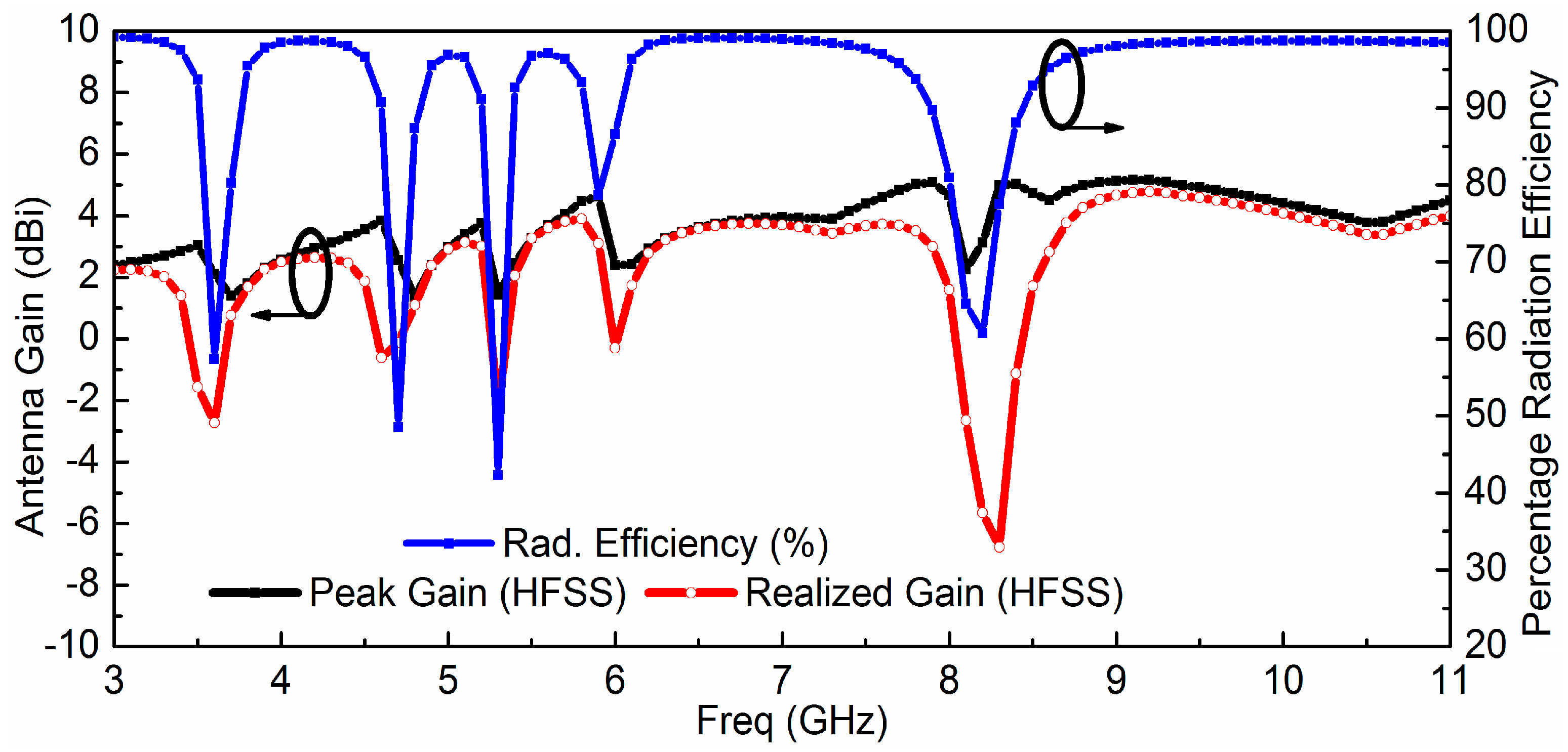The Smallest Form Factor UWB Antenna with Quintuple Rejection Bands for IoT Applications Utilizing RSRR and RCSRR
Abstract
1. Introduction
2. Design and Simulation Results
2.1. Design Equations for the RCSRR and RSRR
2.2. Structural Analysis
2.3. Simulated Input Voltage Standing Wave Ratio (VSWR) (Return–Loss) and Antenna Gain (Radiation Efficiency)
2.4. Parametric Analysis for the Optimal Width of the Resonators (Ws)
3. Measurement Results and Discussions
4. Comparison with Recently Proposed Designs
5. Application of the Proposed Antenna to the Breast Tumor Sensing
6. Conclusions
Acknowledgments
Author Contributions
Conflicts of Interest
References
- The Federal Communications Commission. Revision of Part 15 of the Commission’s Rules Regarding Ultra-Wideband Transmission Systems; The Federal Communications Commission: Washington, DC, USA, 2002.
- Abbas, S.M.; Ranga, Y.; Verma, A.K.; Esselle, K.P. A simple ultra-wideband printed monopole antenna with high band rejection and wide radiation patterns. IEEE Trans. Antennas Propag. 2014, 62, 4816–4820. [Google Scholar] [CrossRef]
- Zhang, J.; Orlik, P.V.; Sahinoglu, Z.; Molisch, A.F.; Kinney, P. UWB Systems for Wireless Sensor Networks. Proc. IEEE 2009, 97, 313–331. [Google Scholar] [CrossRef]
- Chóliz, J.; Hernández, Á.; Valdovinos, A. A Framework for UWB-Based Communication and Location Tracking Systems for Wireless Sensor Networks. Sensors 2011, 11, 9045–9068. [Google Scholar] [CrossRef] [PubMed]
- Valderas, D.; Sancho, J.I.; Puente, D.; Ling, C.; Chen, X. Ultrawideband Antennas: Design and Applications, 1st ed.; Imperial College Press: London, UK, 2010. [Google Scholar]
- Li, X.; Bond, E.J.; Van Veen, B.; Hagness, S. An overview of ultra-wideband microwave imaging via space-time beamforming for early-stage breast-cancer detection. IEEE Antennas Propag. Mag. 2005, 47, 19–34. [Google Scholar]
- Islam, M.T.; Islam, M.M.; Samsuzzaman, M.; Faruque, M.R.I.; Misran, N. A Negative Index Metamaterial-Inspired UWB Antenna with an Integration of Complementary SRR and CLS Unit Cells for Microwave Imaging Sensor Applications. Sensors 2015, 15, 11601–11627. [Google Scholar] [CrossRef] [PubMed]
- Dumoulin, A.; John, M.; Ammann, M.; McEvoy, P. Optimized monopole and dipole antennas for UWB asset tag location systems. IEEE Trans. Antennas Propag. 2012, 60, 2896–2904. [Google Scholar] [CrossRef]
- Ning, H. Unit and Ubiquitous Internet of Things; CRC Press: Boca Raton, FL, USA, 2013. [Google Scholar]
- Klemm, M.; Troester, G. Textile UWB antennas for wireless body area networks. IEEE Trans. Antennas Propag. 2006, 54, 3192–3197. [Google Scholar] [CrossRef]
- Klemm, M.; Kovcs, I.Z.; Pedersen, G.F.; Troster, G. Novel small-size directional antenna for UWB WBAN/WPAN applications. IEEE Trans. Antennas Propag. 2005, 53, 3384–3896. [Google Scholar] [CrossRef]
- Bekasiewic, A.; Koziel, S. Compact UWB monopole antenna for internet of things applications. Electron. Lett. 2016, 52, 492–494. [Google Scholar] [CrossRef]
- Guo, L.; Wang, S.; Chen, X.; Parini, C.G. Study of compact antenna for UWB applications. Electron. Lett. 2010, 46, 115–116. [Google Scholar] [CrossRef]
- Yang, J.; Wang, H.; Lv, Z.; Wang, H. Design of miniaturized dual-band microstrip antenna for WLAN application. Sensors 2016, 16, 983. [Google Scholar] [CrossRef] [PubMed]
- Rotaru, M.; Sykulski, J. Compact Electromagnetic Bandgap Structures for Notch Band in Ultra-Wideband Applications. Sensors 2010, 10, 9620–9629. [Google Scholar] [CrossRef] [PubMed]
- Schantz, H.G.; Wolence, G.; Myszka, E.M. Frequency notched UWB antenna. In Proceedings of the IEEE Conference on Ultra-Wideband Systems and Technologies, Reston, VA, USA, 16–19 November 2003; pp. 214–218. [Google Scholar]
- Kerkhoff, A.; Ling, H. Design of a planar monopole antenna for use with ultra-wideband (UWB) having a band-notched characteristic. In Proceedings of the 2003 IEEE Antennas and Propagation Society International Symposium, Columbus, OH, USA, 22–27 June 2003; Volume 1, pp. 830–833. [Google Scholar]
- Liu, X.L.; Yin, Y.Z.; Liu, P.A.; Wang, J.H.; Xu, B. A CPW-fed dual band-notched UWB antenna with a pair of bended dual-L-shape parasitic branches. Prog. Electromagn. Res. 2013, 136, 623–634. [Google Scholar] [CrossRef]
- Azim, R.; Islam, M.-T. Compact planar UWB antenna with band notch characteristics for WLAN and DSRC. Prog. Electromagn. Res. 2013, 133, 391–406. [Google Scholar] [CrossRef]
- Lotfi, P.; Azarmanesh, M.; Soltani, S. Rotatable dual band-notched UWB/triple-band WLAN reconfigurable antenna. IEEE Antennas Wirel. Propag. Lett. 2013, 12, 104–107. [Google Scholar] [CrossRef]
- Emadian, S.R.; Ghobadi, C.; Nourinia, J.; Mirmozafari, M.H.; Pourahmadazar, J. Bandwidth enhancement of CPW-fed circle-like slot antenna with dual band-notched characteristic. IEEE Antennas Wirel. Propag. Lett. 2012, 11, 543–546. [Google Scholar] [CrossRef]
- Fallahi, R.; Kalteh, A.A.; Roozbahani, M.G. A novel UWB elliptical slot antenna with band-notched characteristics. Prog. Electromagn. Res. 2008, 82, 127–136. [Google Scholar] [CrossRef]
- Tang, Z.J.; Wu, X.F.; Zhan, J. Novel compact band-notched UWB antenna using convex-shaped slot patch. Microw. Opt. Technol. Lett. 2015, 57, 201–203. [Google Scholar] [CrossRef]
- Chu, Q.; Mao, C.; He, Z. A compact notched band UWB slot antenna with sharp selectivity and controllable bandwidth. IEEE Trans. Antennas Propag. 2013, 61, 3961–3966. [Google Scholar] [CrossRef]
- Srivastava, G.; Mohan, A. A planar UWB monopole antenna with dualband notched function. Microw. Opt. Technol. Lett. 2015, 57, 99–104. [Google Scholar] [CrossRef]
- Ding, J.; Lin, Z.; Ying, Z.; He, S. A compact ultra-wideband slot antenna with multiple notch frequency bands. Microw. Opt. Technol. Lett. 2007, 49, 3056–3060. [Google Scholar] [CrossRef]
- Yadav, S.; Gautam, A.K.; Kanaujia, B.K. Design of dual band-notched lamp-shaped antenna with UWB characteristics. Int. J. Microw. Wirel. Technol. 2017, 9, 395–402. [Google Scholar] [CrossRef]
- Shi, R.; Xu, X.; Dong, J.; Luo, Q. Design and analysis of a novel dual band-notched UWB antenna. Int. J. Antennas Propag. 2014, 2014. [Google Scholar] [CrossRef]
- Ryu, K.S.; Kishk, A.A. UWB antenna with single or dual band-notches for lower WLAN band and upper WLAN band. IEEE Trans. Antennas Propag. 2009, 57, 3942–3950. [Google Scholar] [CrossRef]
- Liao, X.J.; Yang, H.C.; Han, N.; Li, Y. Aperture UWB antenna with triple band-notched characteristic. Electron. Lett. 2011, 47, 77–79. [Google Scholar] [CrossRef]
- Xu, J.; Wang, G. A compact printed UWB antenna with triple band-notched characteristics. Microw. Opt. Technol. Lett. 2012, 54, 2146–2150. [Google Scholar] [CrossRef]
- Li, W.T.; Shi, X.W.; Hei, Y.Q. Novel Planar UWB monopole antenna with triple band-notched characteristic. IEEE Antennas Wirel. Propag. Lett. 2009, 8, 1094–1098. [Google Scholar]
- Sarkar, M.; Dwari, S. Printed monopole antenna for ultra-wideband application with tunable triple band-notched characteristics. Wirel. Pers. Commun. 2015, 84, 2943–2954. [Google Scholar] [CrossRef]
- Kim, D.-O.; Kim, C.-Y. CPW-fed ultra-wideband antenna with triple-band notch function. Electron. Lett. 2010, 46, 1246–1248. [Google Scholar] [CrossRef]
- Kim, D.-O.; Jo, N.-I.; Jang, H.-A.; Kim, C.-Y. Design of the ultrawideband antenna with a quadruple-band rejection characteristics using a combination of the complementary split ring resonators. Prog. Electromagn. Res. 2011, 112, 93–107. [Google Scholar] [CrossRef]
- Almalkawi, M.-J.; Devabhaktuni, V.-K. Quad band-notched UWB antenna compatible with WiMAX/ INSAT/ lower/upper-WLAN applications. Electron. Lett. 2011, 47, 1062–1063. [Google Scholar] [CrossRef]
- Sharma, M.-M.; Deegwal, J.-K.; Kumar, A.; Govil, M.-C. Compact Planar Monopole UWB Antenna with quadruple Band-Notched Characteristics. Prog. Electromagn. Res. 2014, 47, 29–36. [Google Scholar] [CrossRef]
- Rahman, M.; Ko, D.-S.; Park, J.-D. A Compact Multiple Notched Ultra-Wide Band Antenna with an Analysis of the CSRR-TO-CSRR Coupling for Portable UWB Applications. Sensors 2017, 17, 2174. [Google Scholar] [CrossRef] [PubMed]
- Liu, J.-J.; Esselle, K.-P.; Hay, S.-G.; Zhong, S.-S. Planar ultra-wideband antenna with five notched stop bands. Electron. Lett. 2013, 49, 579–580. [Google Scholar] [CrossRef]
- Islam, M.M.; Islam, M.T.; Faruque, M.R.I. A parametric study of compact UWB antenna with multiple notched-band functions. In Advances in Machine Learning and Signal Processing; Springer: Berlin/Heidelberg, Germany, 2016; pp. 155–162. [Google Scholar]
- Islam, M.M.; Islam, M.T.; Samsuzzaman, M.; Faruque, M.R.I. Five Band-Notched ultrawideband (UWB) Antenna loaded with C-Shaped Slots. Microw. Opt. Technol. Lett. 2015, 57, 1470–1475. [Google Scholar] [CrossRef]
- Amineh, R.K.; Trehan, A.; Nikolova, N.K. TEM horn antenna for ultra-wide band microwave breast imaging. Prog. Electromagn. Res. B 2009, 13, 59–74. [Google Scholar] [CrossRef]
- Campbell, M.A.; Okoniewski, M.; Fear, E.C. TEM horn antenna for near-field microwave imaging. Microw. Opt. Technol. Lett. 2010, 52, 1164–1170. [Google Scholar] [CrossRef]
- Amineh, R.K.; Ravan, M.; Trehan, A.; Nikolova, N.K. Near-field microwave imaging based on aperture raster scanning with TEM horn antennas. IEEE Trans. Antennas Propag. 2011, 59, 928–940. [Google Scholar] [CrossRef]














| Parameter | Value (mm) | Parameter | Value (mm) | Parameter | Value (mm) | Parameter | Value (mm) |
|---|---|---|---|---|---|---|---|
| Lsub | 30 | L2 | 4.3 | W1 | 25 | W7 | 6.7 |
| Lgnd | 9.0 | L3 | 3.5 | W2 | 2.75 | W8 | 5.9 |
| Wsub | 29 | L4 | 11 | W3 | 1.75 | Ws | 0.30 |
| Wf | 3.0 | L5 | 9.0 | W4 | 6.5 | Lx | 3.4 |
| Lf | 10.3 | L6 | 8.4 | W5 | 12.4 | Ly | 4.4 |
| L1 | 10.5 | L7 | 7.8 | W6 | 9.0 | g1 | 0.3 |
| WiMAX | INSAT | LWLAN | UWLAN | ITU 8 GHz | |
|---|---|---|---|---|---|
| Simulated (f1) | 3.54 | 4.65 | 5.31 | 5.90 | 8.26 |
| Measured (f2) | 3.57 | 4.70 | 5.51 | 6.15 | 8.28 |
| Shift in frequency (∆f = f2 − f1) | 0.03 | 0.05 | 0.20 | 0.25 | 0.02 |
| WiMAX | INSAT | LWLAN | UWLAN | ITU 8 GHz | |
|---|---|---|---|---|---|
| Simulated (f1) | 3.60 | 4.66 | 5.43 | 6.14 | 8.27 |
| Measured (f2) | 3.57 | 4.70 | 5.51 | 6.15 | 8.28 |
| Shift in frequency (∆f = f2 − f1) | 0.03 | 0.04 | 0.08 | 0.01 | 0.01 |
| Literature | Size (mm) | Filtering Bands (GHz) | Remarks |
|---|---|---|---|
| [18] | 40 × 30 | 3.3–3.8 | Antenna reject WiMAX and complete WLAN frequency bands |
| 5.0–6.0 | |||
| [19] | 26 × 24 | 5.1–5.9 | Antenna reject the complete WLAN band |
| [22] | 45 × 50 | 5.1–5.95 | Antenna rejects complete WLAN band |
| [23] | 36 × 22 | 5.1–5.9 | Antenna reject the complete WLAN band with Large size and irregular structure |
| [25] | 25 × 20 | 3.3–3.8 | Antenna rejects the WiMAX and complete WLAN band with stair cased ground plane |
| 5.1–5.85 | |||
| [26] | 33 × 28 | 3.4–3.9 | Rejects WiMAX and upper WLAN bands with three different CSRR pairs |
| 5.6–5.95 | |||
| [27] | 28 × 15 | 3.0–3.9 | Extra band rejection and irregular geometry at the cost of size reduction |
| 4.9–5.8 | |||
| [32] | 36 × 34 | 3.31–3.90 | Triple band rejection with different irregular resonators placements |
| 5.20–5.35 | |||
| 5.8–6.0 | |||
| [33] | 34.6 × 24 | 3.1–3.9 | Extra rejection bands using three different pairs of circular and rectangular CSRRs |
| 4.5–5.35 | |||
| 5.75–6.0 | |||
| [34] | 40 × 40 | 3.1–3.8 | Triple band rejection at the cost of increasing size |
| 5.0–6.0 | |||
| 7.9–8.7 | |||
| [35] | 40 × 40 | 2.37–2.39 | Quad notching at the cost of increased size Extra band-notching for WiMAX and X-band satellite communication while complete WLAN band-notching |
| 3.27–3.76 | |||
| 5.2–5.89 | |||
| 8.06–8.80 | |||
| [36] | 33.5 × 30 | 3.30–3.70 | Quad notching using multilayered structures Notching is not deep enough for good rejection Antenna structure is complex |
| 4.50–4.80 | |||
| 5.10–5.35 | |||
| 5.75–5.95 | |||
| [38] | 30 × 28 | 3.30–3.36 | Quad notching using CSRR structures |
| 4.50–4.70 | |||
| 5.15–5.35 | |||
| 5.70–5.825 | |||
| [39] | 80 × 80 | 1.85–2.49 | Quintuple band-notching with extra rejection bands Size of the antenna is relatively large |
| 2.91–3.40 | |||
| 3.95–5.39 | |||
| 5.65–6.25 | |||
| 7.19–8.78 | |||
| [41] | 31 × 25 | 3.40–3.80 | Compact Quintuple band-notched UWB antenna utilizing different slot resonators Irregular placement of the resonators on the patch and ground plane |
| 5.1–5.35 | |||
| 5.60–6.0 | |||
| 7.15–7.65 | |||
| 8.05–8.65 | |||
| This Work | 28 × 30 | 3.25–3.60 | Compact Quintuple band notching with a simple structure and regularly shaped resonators |
| 4.40–4.80 | |||
| 5.10–5.40 | |||
| 5.75–5.95 | |||
| 7.50–8.75 |
| Type | Dielectric Constant | Conductivity (S/m) | Mass Density (kg/m3) |
|---|---|---|---|
| Skin | 36 | 4 | 1010 |
| Tissue | 50 | 7 | 1040 |
| Tumor | 67 | 5 | 1040 |
© 2018 by the authors. Licensee MDPI, Basel, Switzerland. This article is an open access article distributed under the terms and conditions of the Creative Commons Attribution (CC BY) license (http://creativecommons.org/licenses/by/4.0/).
Share and Cite
Rahman, M.; Park, J.-D. The Smallest Form Factor UWB Antenna with Quintuple Rejection Bands for IoT Applications Utilizing RSRR and RCSRR. Sensors 2018, 18, 911. https://doi.org/10.3390/s18030911
Rahman M, Park J-D. The Smallest Form Factor UWB Antenna with Quintuple Rejection Bands for IoT Applications Utilizing RSRR and RCSRR. Sensors. 2018; 18(3):911. https://doi.org/10.3390/s18030911
Chicago/Turabian StyleRahman, MuhibUr, and Jung-Dong Park. 2018. "The Smallest Form Factor UWB Antenna with Quintuple Rejection Bands for IoT Applications Utilizing RSRR and RCSRR" Sensors 18, no. 3: 911. https://doi.org/10.3390/s18030911
APA StyleRahman, M., & Park, J.-D. (2018). The Smallest Form Factor UWB Antenna with Quintuple Rejection Bands for IoT Applications Utilizing RSRR and RCSRR. Sensors, 18(3), 911. https://doi.org/10.3390/s18030911






